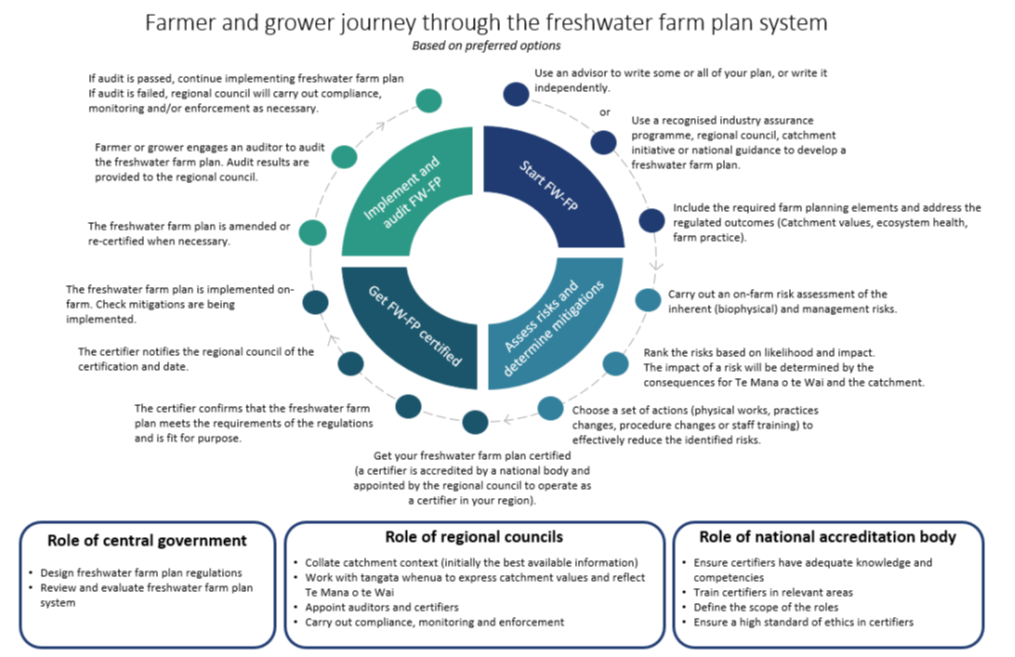Forging Ahead with Freshwater Farm Plans
Topics covered in this article: Business Owners, Farming & Horticulture, RMA, RMA & Local Government
Special Counsel
Phone: +64 7 927 0522
Email: rzame@clmlaw.co.nz
Bachelor of Laws, Bachelor of Science, University of Otago
Forging Ahead with Freshwater Farm Plans – Have Your Say on What’s Proposed
The Government has recently released discussion documents on the proposed content and process for freshwater farm plans (FFP). Introduced as part of the Essential Freshwater package of extensive freshwater reforms in 2019, a FFP will be required (i.e. mandatory) by farmers or growers who have:
-
20 hectares or more in arable or pastoral use;
-
5 hectares or more in horticultural use; or
-
20 hectares or more of combined use.
Recognising that a ‘one size fits all’ approach is not appropriate for on-farm solutions, the proposal is for the FFPs are to be tailored to the operational and physical environment specifics of each farm as well as the goals for the wider catchment, in order to meet regulated outcomes.
FFP are a new legal instrument established under the RMA (to be introduced through regulations). They are different to farm environment plans currently being used by some farmers (for example, Synlait’s Lead with Pride; NZGAP, or the New Zealand Farm Assurance Programme (NZFAP)). The Government has stated that while many of these programmes have an environmental component, they would need to be updated or adapted to deliver a FFP that meets the RMA requirements.
However, the Government has stated that its aim is to not duplicate work already undertaken – with the FFPs to reflect existing resource consent and planning requirements and integrate with farm environment plans and industry assurance programmes currently operating on site. The FFPs will be developed in parallel with the new regional planning provisions falling out of the National Policy Statement for Freshwater 2020 – this means that FFPs may need updating once the regional provisions are notified in December 2024. The reliance on resource consenting and blanket planning rules may eventually be reduced as the reliance on FFPs increases.
As currently proposed farmers and growers would be able to develop and write their own FFP to meet the stated requirements; and the FFP would then be reviewed and certified by a qualified certifier – however feedback is sought on whether certifiers should help with writing the FFP. Auditors will check that the farm complies with its FFP, with farmers to engage and pay for auditing services.
A summary of the process has been included as Figure 2 of the consultation documents:
The current proposal is for the regulations to contain specific regulated outcomes covering:
- catchment values and context;
- ecosystem health; and
- farm practice.
The regulations can also prescribe minimum content or ‘base information’ such as mapping information (including owned and leased paddocks that are managed as a single economic unit), farm ownership and farm systems. The information proposed to be mapped is relatively detailed – with mapping of the natural environment to include waterways, lakes, wetlands, riparian areas, significant indigenous freshwater biodiversity and habitat, mahinga kai sites, covenants, farmed areas (including soil type, land slope, land management units and critical source areas); and built environment including feed pads, yards, stock holding infrastructure, river crossings, point source discharges, drainage systems, erosion control assets, irrigation and effluent systems and drinking water protection zones.
The current proposal is for the regulations to require a risk/impact assessment to identify any adverse effects of activities carried out on farm on freshwater and freshwater ecosystems. This would cover both inherent risk (i.e. the biophysical characteristics of the land) and management risk (being the management practices on farm), and how those risks interact to impact on freshwater. The proposal provides two options for consultation – a set of minimum general requirements for the risk/impact assessment; and prescribing a specific methodology.
Once the risks/impacts have been identified and prioritised, appropriate actions would then need to be identified and prioritised to address the risks/impacts. The Government has identified several ways to achieve this – either through the prescribing of high level factors, but then relying on the certifier’s discretion and professional judgement to determine the appropriateness of specific actions; a detailed approach through prescribed practice standards; or a hybrid of those options.
Finally, the discussion documents provide some options around the certification and auditing process.
When will the requirements come in and how can you be involved?
The requirement for FFPs will be rolled out on a staggered basis, either catchment by catchment or farm by farm – and the Government is seeking feedback from farmers and growers on how the rollout should occur. The rollout is set to start following the regulations coming into force in the first half of 2022.
Have your say
Feedback is sought on the regulations currently under development for the content and operational aspects of FFPs. The discussion document can be found here for detailed information about what is proposed.
Submissions are due by 26 September 2021. If you need help preparing a submission or have any questions, please contact our Resource Management team.
Last Update: 3 September 2021






